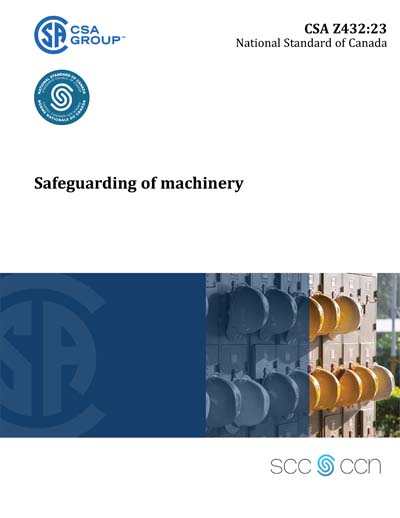Most recent
CSA Z432-2023
Safeguarding of machinery
Preface This is the fourth edition of CSA Z432, Safeguarding of machinery. It supersedes the previous editions published in 2016, 2004, and 1994. This Standard specifies requirements for the design, manufacture (including remanufacture and rebuilding), installation, maintenance, operation, and safeguarding of industrial equipment to prevent injuries and accidents and enhance the safety of personnel who operate, assemble, and maintain machinery. The major changes to this edition include the following: a) restructure flow of document to align with hierarchy of control; b) updates for continued alignment with applicable ISO standards and ANSI B11.19; and c) updates to Clause 6. This Standard was developed by CSA Group with funding support provided by the Canadian Association of Administrators of Labour Law — Occupational Safety and Health (CAALL-OSH), including Provincial and Territorial Governments, as well as the Government of Canada. CSA Group is solely responsible for the content of this Standard, and CSA Group and the funding bodies disclaim any liability in connection with the use of the information contained herein. Clauses 7.2.5.1, 7.2.9, 7.2.10, 7.2.11 (modified), 7.2.13 (modified), 7.3.2.1, 9.2.1 (modified), 9.2.2 (modified), 9.2.3 (modified), 9.2.5.1, 9.3.1, 9.3.3.2, 9.3.3.4, 9.3.5 (modified), 9.5.3 (modified), and 9.23.3 are copied from ISO 12100:2010 by CSA Group with the permission of the Standards Council of Canada (SCC) on behalf of ISO. ISO 12100 can be purchased from the national ISO member in your country or the ISO Store. Copyright remains with ISO. Clauses J.5.1 (modified) and J.5.2 (modified) are copied from ISO 13849-1:2015 by CSA Group with the permission of the Standards Council of Canada (SCC) on behalf of ISO. ISO 13849-1 can be purchased from the national ISO member in your country or the ISO Store. Copyright remains with ISO. This Standard was prepared by the Technical Committee on Safeguarding of Machinery, under the jurisdiction of the Strategic Steering Committee on Occupational Health and Safety, and has been formally approved by the Technical Committee. This Standard has been developed in compliance with Standards Council of Canada requirements for National Standards of Canada. It has been published as a National Standard of Canada by CSA Group. Scope 1.1 General This Standard applies to the protection of workers from the hazards arising from the use of mobile or stationary machinery. It provides the criteria to be observed and the description, selection, and application of guards and protective devices. Where a current CSA standard exists for a specific type of machinery (e.g., CSA B167, CAN/CSA-B354.2, CSA M424.1, CSA Z142, CSA Z248, and CAN/CSA-Z434), it is to be used in conjunction with this Standard to provide the most effective protection. Note: This Standard is intended to be applied to newly manufactured and newly installed machinery as of the publication date of this Standard. The aim of this Standard is to promote a high standard of machinery safety during use. This Standard describes a variety of risk reduction measures and provides guidance to determine which measure(s) to use. As a minimum it will, however, be necessary to consult specific legislation in applying the principles set down. Although reference is made to specific types of machines, specific recommendations are not given for every type of machine. This Standard applies to rebuilt or redeployed machinery. The Standard can be used for enhancing the safety of existing machinery. 1.2 Exclusions This Standard does not apply to portable hand tools. 1.3 Purpose This Standard is intended for those who design, build, modify, install, use, operate, or maintain machinery, machinery guarding, or protective devices. It is also intended to be used by those concerned with information for use of the machinery and the development and implementation of instructions, and training and the effective implementation of administrative controls. 1.4 Interaction with other standards Workplace safety is more than machinery safeguarding. Typically, machinery is installed in workplaces with other risks (e.g., movement of materials, cables, pipes, and hoses supplying energy, gases, and liquids, and workers on foot and operating vehicles). Other applicable machinery and workplace standards should therefore be reviewed. 1.5 Terminology In this Standard, “shall” is used to express a requirement, i.e., a provision that the user is obliged to satisfy in order to comply with the Standard; “should” is used to express a recommendation or that which is advised but not required; and “may” is used to express an option or that which is permissible within the limits of the Standard. Notes accompanying clauses do not include requirements or alternative requirements; the purpose of a note accompanying a clause is to separate from the text explanatory or informative material. Notes to tables and figures are considered part of the table or figure and may be written as requirements. Annexes are designated normative (mandatory) or informative (non-mandatory) to define their application. 1.6 Measurements The values given in SI units are the units of record for the purposes of this Standard. The values given in parentheses are for information and comparison only.
CSA America, Inc. [csa]

